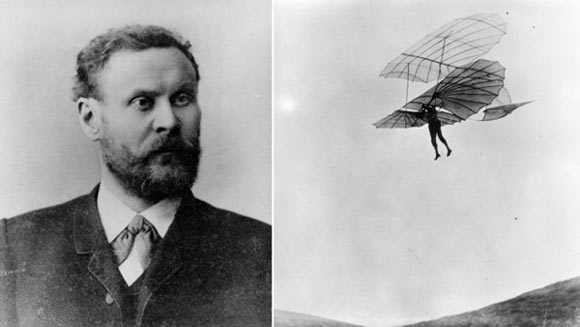Otto Lilienthal invented “Hang Glider”
Otto Lilienthal was a German aviation expert, credited with being the first person in history for making multiple successful gliding flights. Lilienthal was born to a middle-class family in Prussia (now part of Germany) in 1848 and attended grammar school in Anklam. As a young child along with his brother Gustav was very interested in studying birds. The brothers developed strap-on wings but failed to make them fly. Lilienthal then attended the Royal Technical Academy in Berlin and learned in mechanical engineering. He volunteered in the Franco-Prussian War which was finished in 1871.
During his studies at the Royal Technical Academy in Berlin, he started experimenting with flight. In 1867, he along with his brother built their first wooden glider. Their glider failed to take off but Lilienthal continued with his attempts on his own by trying to build other winged vehicles. After leaving the military in 1871, Lilienthal worked as an engineer until 1833 but spent all of his spare time conducting research and experiments related to aviation. Lilienthal and Gustav joined the Aeronautical Society of Great Britain in 1873. He gave his first public talk on flight in the same year.
Otto Lilienthal tried to develop artificial wings modeled on the structure of birds’ wings and tried to understand how they responded to different amounts of air pressure and the force of wind. He also invented and patented various other devices which include children’s building blocks and a mining machine. In all, he patented 25 inventions, of which four were related to aviation.
Lilienthal then opened his own manufacturing facility in Berlin where he produced steam engines and boilers. He also invented a small engine that was safer than the ones they had at present. The engine consisted of a system of tubular boilers and was very successful and helped him earn enough to be able to dedicate more of his time to the study of aviation. In 1889 he wrote a book about the flight of birds and its relation to aviation. This book was called “Birdflight As the Basis of Aviation: A Contribution Towards a System of Aviation” and it remains one of the foremost theories on aviation today. In this book, Lilienthal discussed the different structures and types of birds’ wings and did an analysis of the aerodynamics of flight. He became an authority on the field and numerous scientists and researchers took his counsel on the subject, especially towards the end of his life.
In 1891, Lilienthal went back to building gliders. One of his first successful models was the Derwitzer Glider, which was able to fly to a height of 80 feet. Lilienthal was able to control the direction of the glider by shifting his body weight around. A more refined version of this was built the following year in 1892 which soared up to 270 feet, and then a subsequent one which flew up to 1150 feet in height. Otto Lilienthal’s most successful design was the Normal-Segelapparat, or “Standard Soaring Apparatus”. This one was recreated for people in other countries including the United States, England, France, and Russia.
Over the span of his life, he took more than 2000 flights and built 18 glider models. His death was due to a tragic gliding accident in 1896 and his famous last words were “Sacrifices must be made”. Lilienthal was a pioneer in aviation and his work in the field was the precursor of many advancements and discoveries in the field of aviation.
